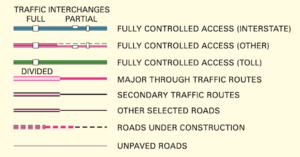User:Ezekielf/Enhanced highways
While changing highway=trunk to a functional classification in Vermont I've been thinking quite a bit about which roads in the state and elsewhere should get expressway=yes. This page explains my thinking on the topic and some open questions I have yet to resolve.
Enhanced roads on American highway maps
American style highway maps commonly use distinct line styles to differentiate enhanced highways from conventional highways. On map legends these are generally labelled with one or more of the following terms which: freeway, expressway, controlled access highway, limited access highway, divided highway, multi-lane highway. These terms do not all mean the same thing although they have similarities and overlaps. In the Americana map style we'd like to highlight roads with enhanced construction, and are planning to use expressway=yes to drive this rendering decision. However, sometimes it's not entirely clear if a particular road should qualify as an expressway or not. This is particularly true in a rural state like Vermont where even our enhanced roads are much smaller than those in higher population areas.
Term Definitions
These terms may have slightly different meanings in other contexts, but for the sake of this discussion here is what I am using them to mean:
Limited access
There are a limited number of intersections with other roads. Many side roads are bypassed. There no driveways to adjacent properties, or at least very few.
Partially controlled access
Access to the road is via on/off ramps and/or right-in, right-out intersections in some places, but in others access is via standard intersections. This implies limited access as well.
Fully controlled access
Access to the road is only via on/off ramps and/or right-in, right-out intersections. This implies limited access as well.
Conventional style guide signage
Smaller guide signage (green signs) typically seen on lower speed roads as described in MUTCD Chapter 2D. Guide Signs—Conventional Roads.
Freeway style guide signage
Larger guide signage (green signs) typically seen on higher speed roads as described in MUTCD Chapter 2E. Guide Signs—Freeways and Expressways.
Vermont enhanced road types
Fully controlled access, divided highways
This category covers the Interstates (I-89, I-189, I-91, and I-93) as well as US-4 west of Rutland. These are all divided highways built to full freeway standards with access fully controlled by on/off ramps and grade separation. Guide signage is freeway style. They look like freeways. They feel like freeways. They are freeways.
Fully controlled access, undivided highways
VT-289, VT-279, US-7 between Dorset and Bennington, and a short section of VT-127 fit the description of a two-lane expressway, also known as a two-lane freeway or undivided expressway. These are undivided two-lane roads (some have a few divided sections), but access is fully controlled, and they have full grade separation with interchanges, overpasses, and underpasses. The gentle curves, on/off ramps, and freeway style guide signage on these roads definitely gives them a freeway vibe, but the fact that they are undivided can make them feel a bit more like a conventional highway at times.
Limited access, divided highways
A section of US-7 just south of Rutland, and a very short section of Memorial drive in Montpelier fit the prototypical description of an expressway. They are limited access, mostly divided highways with freeway style guide signage. However they have no controlled access points (on/off ramps), just a limited number of standard intersections. VT-62 between I-89 and Barre is similar but less consistent. It has one set of on/off ramps where Berlin State Highway joins it, an undivided section, and guide signage is a mix of conventional and freeway style. Parts of these roads very much have a freeway vibe, but the intersections interrupt that.
Limited access, undivided highways
US-2 west of Saint Johnsbury, US 2 west of I-89 in Colchester and Milton, VT-63 in Barre, VT-313 in Arlington, VT-100 Morristown bypass, and VT-191 in Newport are all examples of this type of road. They are limited access, but mostly undivided with two to three lanes in most places. Some have enhanced intersections with slip roads to help prioritize through traffic. Intersections generally do not prevent cross traffic though. Signage is mostly conventional style, but some freeway style is present as well. These roads definitely feel designed for high speed with their gentle curves, infrequent intersections, and lack of driveways. However, they don't have much of a freeway vibe since they lack on/off ramps and are mostly undivided.
Divided highways
A section of VT-15 in Colchester/Essex and a section of US-7 in South Burlington/Shelburne are example of this road type. These are divided highways with two lanes in either direction. However, there are plenty of driveways and intersections so access is not really limited. The physical median does provide a small degree of access control since it prevents left turns out of most driveways. Guide signage is conventional. Despite being divided highways, the freeway vibe on these roads is low.
